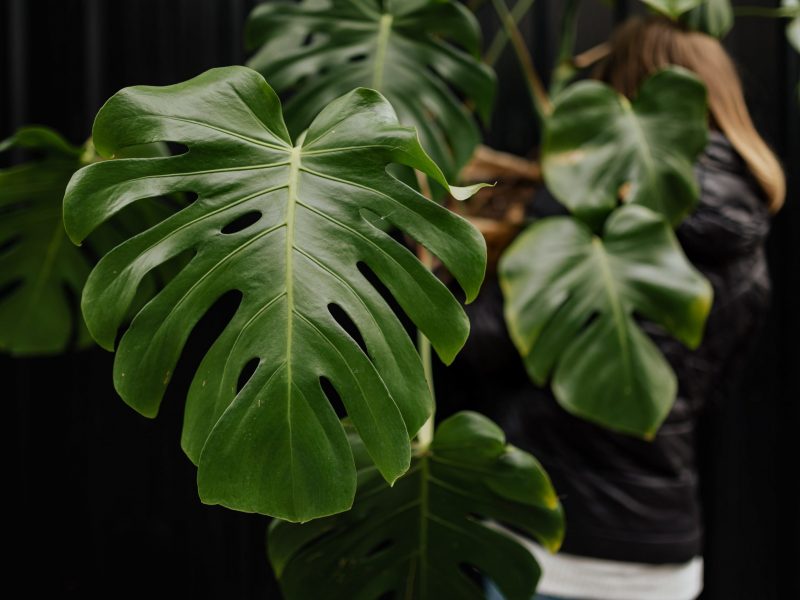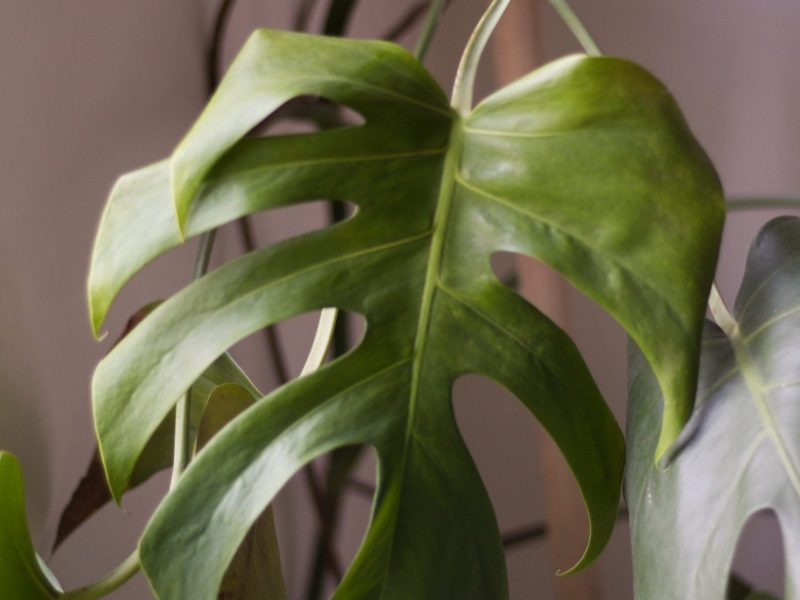
Probably the most popular houseplant in the world, the Monstera is known and loved for its thick, dark green split leaves. There isn’t much more iconic than the Monstera leaf, which makes it pretty worrying when your plant starts to lose them. Unlike a lot of other houseplants, Monsteras don’t actually have that many leaves, but what they lack in quantity they sure as hell make up in beauty. If your Monstera is losing leaves frequently then there is definitely something wrong with either the environment that your plant is in or the care it’s receiving.
To properly diagnose why your Monstera is losing leaves, we have created this post which goes through each of the factors in detail so you can see what fits with your plant and get right to solving and preventing the problem.
Overwatering is the most common cause of leaves falling off Monstera plants
If your Monstera’s leaves have yellow patches before they fall off then overwatering is most likely to blame here. It can be really easy to accidentally overwater your Monstera because it’s difficult to see what’s really happening in the soil. Monstera plants have quite thick roots compared to a lot of other more delicate houseplants which means they can withstand the odd overwatering or lack of drainage. However, if the problem is frequent, and the soil never has a chance to dry out, the roots will start to turn mushy and rot. This leaves the plant unable to get the needed nutrients, oxygen and moisture and your Monstera will start to lose leaves to conserve the energy that it does have.
It’s important before you go changing anything about how you care for your Monstera that you are sure overwatering is the cause of the problem. Luckily, there are a few simple ways to find out if your Monstera’s soil is waterlogged and causing your plant to lose leaves:
Carefully take your Monstera out of its pot
If your Monstera plant is losing a lot of leaves then you need to inspect the potting mix immediately. You’ll be able to tell very quickly if the soil is waterlogged and clumpy. If it is then replace it with fresh potting mix immediately so your Monstera can begin to recover straight away.
Finger/Chopstick Method
Another way to tell if your potting mix is waterlogged is by putting a finger or chopstick into the soil and seeing if it comes out clean. If there is soil stuck then there is still moisture in the soil. But if the soil is bone dry then it will just be like dust which will fall off your finger.
Use a moisture meter
These are affordable little devices that make it super easy to tell how much moisture is in the soil. They are great for all of your houseplants too, so the perfect investment for every houseplant.
Do I risk damaging the root system if I stick my finger in the soil?
As long as you are careful and don’t prod around too much, then you shouldn’t cause too many issues. Monstera plants have quite a robust root system so can deal with a little bit of prodding. Even if you break the odd root with your moisture meter, it shouldn’t be anything to lose sleep over.
How do I fix an overwatered Monstera?
If overwatering is the cause of your Monstera losing leaves then you must act quickly to fix the problem. Replace the potting mix straight away instead of letting it dry out naturally and trim away the worst affected roots and leaves. This stops your Monstera from wasting any energy trying to revive them and allows your plant to fully focus on new healthy growth.
In future, to prevent any more leaves from falling off your Monstera, try to hold off watering as much and make sure that the potting mix has fully dried out before watering again. Using a moisture meter can really help to gauge when to water.
Underwatering can also cause leaves to fall off
Although too much water can mean your Monstera loses leaves, not enough can also have exactly the same outcome. The main difference here though is that the leaves will most commonly turn brown, dry and crispy before falling off (rather than yellow and soft with overwatering).
If it’s not immediately obvious, here are some other indicators that your Monstera is losing leaves due to a lack of water:
Leaves are dry and crispy to touch
If the leaves that are falling off are very dry, crispy, shrivelled and look dehydrated, then the problem is probably consistent underwatering.
The potting mix feels very dry
An easy way to see if your Monstera is losing leaves due to a lack of water is by taking the plant out of its pot and inspecting the potting mix. If the soil feels very dry to touch (almost like dust) then there is a good chance your Monstera needs more frequent watering.
The soil is coming away from the sides of the pot
This is a great method to be able to tell if your Monstera is being underwatered without needing to even take it out of the pot. If you notice that the soil has compacted and is actually coming away from the sides of your plant’s pot, then it indicates that you need to increase watering and this may be the cause of your Monstera losing leaves.
Use a moisture meter
Just like with overwatering above, using a moisture meter will help figure out how dry the potting mix is and if you need to water more to stop your plant from losing any more leaves. It’s the most reliable method as you can monitor how the moisture levels change and make sure you are watering your plant enough.
How do I fix an underwatered Monstera?
To revive an underwatered Monstera, you might think all it needs is a bucket full of water. However, houseplants can get stressed by sudden changes in their environment. This can be sunlight, temperature and moisture levels. To avoid your Monstera getting stressed, you want to slowly reintroduce water by giving it a little bit once a day for a week. This will also ensure that the water is being taken up by the plant. When you water really dry soil, often most of that will run straight through the drainage holes and won’t be taken up by the roots.
Extremely low temperatures
If you can’t seem to find a problem with the amount of water that your Monstera is getting then cold temperatures may be what also be causing your Monstera to lose leaves. Cold air coming in through air conditioning vents or drafty windows can shock your plant and your Monstera might shed some of its leaves as a result. It can be difficult to notice drafts as often the average room temperature will feel fine, so it’s best to pick up a digital thermometer so you can keep an eye on how the temperature fluctuates.
Environmental Stress
Much like humans, Monstera plants can get pretty stressed out if any changes occur. We mentioned this a little above with watering but it can also happen after things like repotting, propagating or moving to a new spot in your home (or an entirely new home for that matter).
As long as the environment and care are what your Monstera needs, the initial shock will wear off after a few weeks and your Monstera shouldn’t lose too many leaves. Using a light meter and digital thermometers are a great way to check the environment and ensure that nothing is wrong.
Lack of nutrients can also be damaging
One issue that is slightly harder to diagnose but still might be causing your Monstera to drop leaves is a lack of nutrients. This usually occurs in more mature plants when you haven’t switched the soil out in a while so we recommend repotting with a good rich potting mix or compost. We also use a liquid fertiliser during summer to help with growth.
Natural ageing
If you have gone through all of the potential issues above but none of it really fits what is going on with your Monstera then it may simply be natural ageing. Over time it’s totally normal for your Monstera to drop some of its oldest leaves as it focuses on new bigger growth. The leaves that fall off due to natural ageing will usually turn a very vibrant, solid yellow colour. Once they are completely yellow they will fall from the plant. If natural ageing is the cause, then the rest of the plant should look and feel completely healthy.
To be sure that it is natural ageing, it’s also a good idea to monitor the rate at which leaves are falling off your Monstera. Ensure that your plant is growing more new leaves than it is losing old ones. If it’s the other way around then there is probably something wrong.
Those are the main reasons why Monstera plants lose their leaves. The number 1 thing to do when you notice your Monstera is losing leaves is to act quickly. If the problem has progressed this far, then it means it has been going on for a while (unless it is natural shedding of course). The sooner that you fix the problem, the better chance you have at getting your plant back to its normal self. Keep a close eye on other changes in your plant to give you the best shot at diagnosing the issue.
To learn more about how to best care for your beloved plant, as well as the different methods you can use to propagate it and how to spot and treat other common problems, check out our Monstera care guide.














